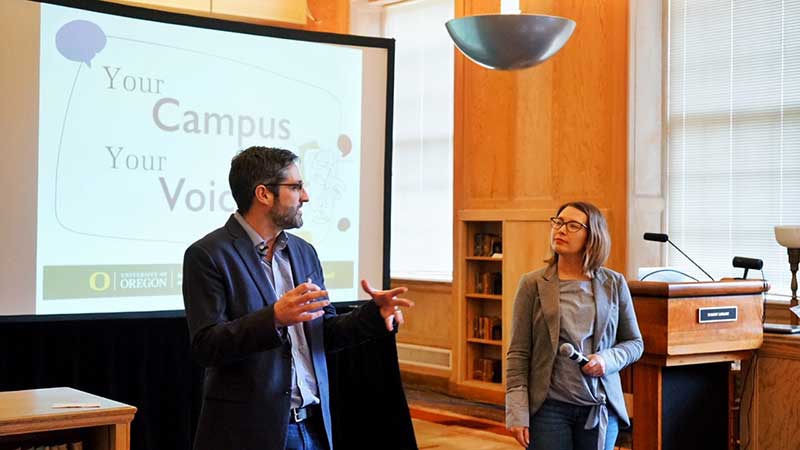
The statistic is startling: Just 32 percent of Americans — fewer than 1 in 3 — say they trust the media to report factual, honest, and bias-free news.
But what’s driving that growing sense of distrust? And what might be done to repair it?
Those questions are at the heart of a year-long research project from the University of Oregon School of Journalism and Communication (SOJC). Researchers and journalists Lisa Heyamoto and Todd Milbourn hosted a series of community workshops in public libraries around the country to get a ground-level understanding of how trust operates in people’s personal lives, and identify strategies for producing more trustworthy journalism. The project was funded by a grant from the SOJC’s Portland-based Agora Journalism Center, the UO’s research and gathering place for innovation in communication and civic engagement.
The team’s research is now available in a report titled “The 32 Percent Project: Exploring How Citizens Define Trust and How Journalists Can Earn It.”
“Building trust is critical for the future of journalism and democracy,” Milbourn said. “But you can’t effectively build trust until you understand what drives and disrupts it. That’s what this project is all about — developing a deeper understanding of those dynamics.”

Heyamoto and Milbourn analyzed comments from 54 workshop participants and identified six “trust conditions” that citizens say news organizations must meet to be trustworthy. Based on that research, the authors offer four strategies news organizations can employ to build greater trust in the communities they serve. Those strategies include making the process of journalism much more transparent, embracing solutions-oriented coverage, elevating diverse local voices and using the tools of community engagement to deepen relationships with the public.
“We think these insights — and the recommendations the authors offer — could not come at a more opportune time, as the news industry struggles to adapt to a rapidly changing technological, social and political environment and a public that is far less inclined to accept news at face value,” wrote Regina Lawrence, executive director of the Agora Journalism Center and the SOJC in Portland, in the report’s foreword.
Although several research teams around the country are exploring the issue of trust in the news media, the UO project is distinct because it uses the tools of community engagement to listen deeply to diverse voices. The project spanned geographic, urban/rural, racial, economic and political divides to gather insights from avid news consumers alongside those who don’t engage with the news at all — or who chose to opt out long ago.
Heyamoto and Milbourn, who are married, are both journalism instructors at the UO School of Journalism and Communication. Heyamoto is coordinator of the school’s multimedia storytelling sequence, and Milbourn is co-director of the journalism master’s program. Before joining UO, both worked for more than a decade as reporters for The Sacramento Bee, The Seattle Times and other news outlets.
